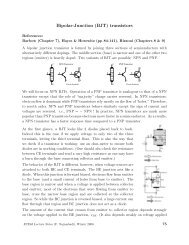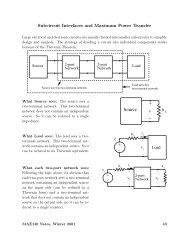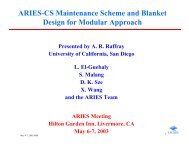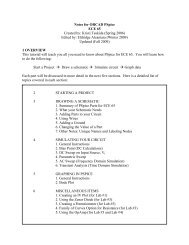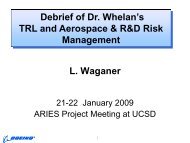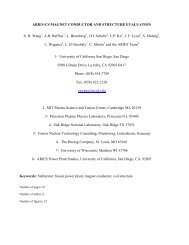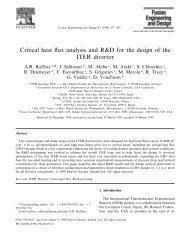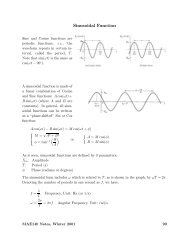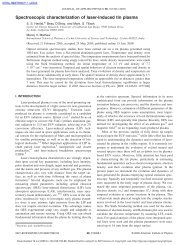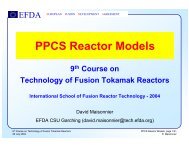TECHNOLOGY READINESS LEVELS A White Paper April 6 ... - NASA
TECHNOLOGY READINESS LEVELS A White Paper April 6 ... - NASA
TECHNOLOGY READINESS LEVELS A White Paper April 6 ... - NASA
You also want an ePaper? Increase the reach of your titles
YUMPU automatically turns print PDFs into web optimized ePapers that Google loves.
<strong>TECHNOLOGY</strong> <strong>READINESS</strong> <strong>LEVELS</strong><br />
A <strong>White</strong> <strong>Paper</strong><br />
<strong>April</strong> 6, 1995<br />
John C. Mankins<br />
Advanced Concepts Office<br />
Office of Space Access and Technology<br />
<strong>NASA</strong><br />
Introduction<br />
Technology Readiness Levels (TRLs) are a systematic metric/measurement system that<br />
supports assessments of the maturity of a particular technology and the consistent<br />
comparison of maturity between different types of technology. The TRL approach has<br />
been used on-and-off in <strong>NASA</strong> space technology planning for many years and was recently<br />
incorporated in the <strong>NASA</strong> Management Instruction (NMI 7100) addressing integrated<br />
technology planning at <strong>NASA</strong>. Figure 1 (attached) provides a summary view of the<br />
technology maturation process model for <strong>NASA</strong> space activities for which the TRL’s were<br />
originally conceived; other process models may be used. However, to be most useful the<br />
general model must include: (a) ‘basic’ research in new technologies and concepts<br />
(targeting identified goals, but not necessary specific systems), (b) focused technology<br />
development addressing specific technologies for one or more potential identified<br />
applications, (c) technology development and demonstration for each specific application<br />
before the beginning of full system development of that application, (d) system<br />
development (through first unit fabrication), and (e) system ‘launch’ and operations.<br />
Technology Readiness Levels Summary<br />
TRL 1<br />
TRL 2<br />
TRL 3<br />
TRL 4<br />
TRL 5<br />
TRL 6<br />
TRL 7<br />
TRL 8<br />
TRL 9<br />
Basic principles observed and reported<br />
Technology concept and/or application formulated<br />
Analytical and experimental critical function and/or characteristic proof-ofconcept<br />
Component and/or breadboard validation in laboratory environment<br />
Component and/or breadboard validation in relevant environment<br />
System/subsystem model or prototype demonstration in a relevant<br />
environment (ground or space)<br />
System prototype demonstration in a space environment<br />
Actual system completed and “flight qualified” through test and<br />
demonstration (ground or space)<br />
Actual system “flight proven” through successful mission operations<br />
028
Discussion of Each Level<br />
The following paragraphs provide a descriptive discussion of each technology readiness<br />
level, including an example of the type of activities that would characterize each TRL.<br />
TRL 1<br />
Basic principles observed and reported<br />
This is the lowest “level” of technology maturation. At this level, scientific research begins<br />
to be translated into applied research and development. Examples might include studies<br />
of basic properties of materials (e.g., tensile strength as a function of temperature for a<br />
new fiber).<br />
Cost to Achieve: Very Low ‘Unique’ Cost<br />
(investment cost is borne by scientific research programs)<br />
TRL 2<br />
Technology concept and/or application formulated<br />
Once basic physical principles are observed, then at the next level of maturation, practical<br />
applications of those characteristics can be ‘invented’ or identified. For example, following<br />
the observation of high critical temperature (Htc) superconductivity, potential applications<br />
of the new material for thin film devices (e.g., SIS mixers) and in instrument systems (e.g.,<br />
telescope sensors) can be defined. At this level, the application is still speculative: there is<br />
not experimental proof or detailed analysis to support the conjecture.<br />
Cost to Achieve: Very Low ‘Unique’ Cost<br />
(investment cost is borne by scientific research programs)<br />
TRL 3<br />
Analytical and experimental critical function and/or<br />
characteristic proof-of-concept<br />
At this step in the maturation process, active research and development (R&D) is initiated.<br />
This must include both analytical studies to set the technology into an appropriate context<br />
and laboratory-based studies to physically validate that the analytical predictions are<br />
correct. These studies and experiments should constitute “proof-of-concept” validation of<br />
the applications/concepts formulated at TRL 2. For example, a concept for High Energy<br />
Density Matter (HEDM) propulsion might depend on slush or super-cooled hydrogen as a<br />
propellant: TRL 3 might be attained when the concept-enabling<br />
phase/temperature/pressure for the fluid was achieved in a laboratory.<br />
Cost to Achieve: Low ‘Unique’ Cost<br />
(technology specific)<br />
028
TRL 4<br />
Component and/or breadboard validation in laboratory<br />
environment<br />
Following successful “proof-of-concept” work, basic technological elements must be<br />
integrated to establish that the “pieces” will work together to achieve concept-enabling<br />
levels of performance for a component and/or breadboard. This validation must devised to<br />
support the concept that was formulated earlier, and should also be consistent with the<br />
requirements of potential system applications. The validation is relatively “low-fidelity”<br />
compared to the eventual system: it could be composed of ad hoc discrete components in<br />
a laboratory. For example, a TRL 4 demonstration of a new ‘fuzzy logic’ approach to<br />
avionics might consist of testing the algorithms in a partially computer-based, partially<br />
bench-top component (e.g., fiber optic gyros) demonstration in a controls lab using<br />
simulated vehicle inputs.<br />
Cost to Achieve: Low-to-moderate ‘Unique’ Cost<br />
(investment will be technology specific, but probably<br />
several factors greater than investment required for TRL 3)<br />
TRL 5<br />
Component and/or breadboard validation in relevant<br />
environment<br />
At this, the fidelity of the component and/or breadboard being tested has to increase<br />
significantly. The basic technological elements must be integrated with reasonably realistic<br />
supporting elements so that the total applications (component-level, sub-system level, or<br />
system-level) can be tested in a ‘simulated’ or somewhat realistic environment. From oneto-several<br />
new technologies might be involved in the demonstration. For example, a new<br />
type of solar photovoltaic material promising higher efficiencies would at this level be used<br />
in an actual fabricated solar array ‘blanket’ that would be integrated with power supplies,<br />
supporting structure, etc., and tested in a thermal vacuum chamber with solar simulation<br />
capability.<br />
Cost to Achieve: Moderate ‘Unique’ Cost<br />
(investment cost will be technology dependent, but likely to be several factors<br />
greater that cost to achieve TRL 4)<br />
TRL 6<br />
System/subsystem model or prototype demonstration<br />
in a relevant environment (ground or space)<br />
A major step in the level of fidelity of the technology demonstration follows the completion<br />
of TRL 5. At TRL 6, a representative model or prototype system or system — which would<br />
go well beyond ad hoc, ‘patch-cord’ or discrete component level breadboarding — would<br />
be tested in a relevant environment. At this level, if the only ‘relevant environment’ is the<br />
environment of space, then the model/prototype must be demonstrated in space. Of<br />
028
course, the demonstration should be successful to represent a true TRL 6. Not all<br />
technologies will undergo a TRL 6 demonstration: at this point the maturation step is driven<br />
more by assuring management confidence than by R&D requirements. The demonstration<br />
might represent an actual system application, or it might only be similar to the planned<br />
application, but using the same technologies. At this level, several-to-many new<br />
technologies might be integrated into the demonstration. For example, a innovative<br />
approach to high temperature/low mass radiators, involving liquid droplets and composite<br />
materials, would be demonstrated to TRL 6 by actually flying a working, sub-scale (but<br />
scaleable) model of the system on a Space Shuttle or International Space Station ‘pallet’.<br />
In this example, the reason space is the ‘relevant’ environment is that microgravity plus<br />
vacuum plus thermal environment effects will dictate the success/failure of the system —<br />
and the only way to validate the technology is in space.<br />
Cost to Achieve: Technology and demonstration specific; a fraction<br />
of TRL 7 if on ground; nearly the same if space is required<br />
TRL 7<br />
System prototype demonstration in a space environment<br />
TRL 7 is a significant step beyond TRL 6, requiring an actual system prototype<br />
demonstration in a space environment. It has not always been implemented in the past. In<br />
this case, the prototype should be near or at the scale of the planned operational system<br />
and the demonstration must take place in space. The driving purposes for achieving this<br />
level of maturity are to assure system engineering and development management<br />
confidence (more than for purposes of technology R&D). Therefore, the demonstration<br />
must be of a prototype of that application. Not all technologies in all systems will go to this<br />
level. TRL 7 would normally only be performed in cases where the technology and/or<br />
subsystem application is mission critical and relatively high risk. Example: the Mars<br />
Pathfinder Rover is a TRL 7 technology demonstration for future Mars micro-rovers based<br />
on that system design. Example: X-vehicles are TRL 7, as are the demonstration projects<br />
planned in the New Millennium spacecraft program.<br />
Cost to Achieve: Technology and demonstration specific,<br />
but a significant fraction of the cost of TRL 8<br />
(investment = “Phase C/D to TFU” for demonstration system)<br />
TRL 8<br />
Actual system completed and “flight qualified” through test and<br />
demonstration (ground or space)<br />
By definition, all technologies being applied in actual systems go through TRL 8. In almost<br />
all cases, this level is the end of true ‘system development’ for most technology elements.<br />
Example: this would include DDT&E through Theoretical First Unit (TFU) for a new<br />
reusable launch vehicle. This might include integration of new technology into an existing<br />
system. Example: loading and testing successfully a new control algorithm into the<br />
onboard computer on Hubble Space Telescope while in orbit.<br />
028<br />
Cost to Achieve: Mission specific; typically highest unique cost for a new technology<br />
(investment = “Phase C/D to TFU” for actual system)
TRL 9<br />
Actual system “flight proven” through successful<br />
mission operations<br />
By definition, all technologies being applied in actual systems go through TRL 9. In almost<br />
all cases, the end of last ‘bug fixing’ aspects of true ‘system development’. For example,<br />
small fixes/changes to address problems found following launch (through ‘30 days’ or some<br />
related date). This might include integration of new technology into an existing system<br />
(such operating a new artificial intelligence tool into operational mission control at JSC).<br />
This TRL does not include planned product improvement of ongoing or reusable systems.<br />
For example, a new engine for an existing RLV would not start at TRL 9: such ‘technology’<br />
upgrades would start over at the appropriate level in the TRL system.<br />
Cost to Achieve: Mission Specific; less than cost of TRL 8<br />
(e.g., cost of launch plus 30 days of mission operations)<br />
028



